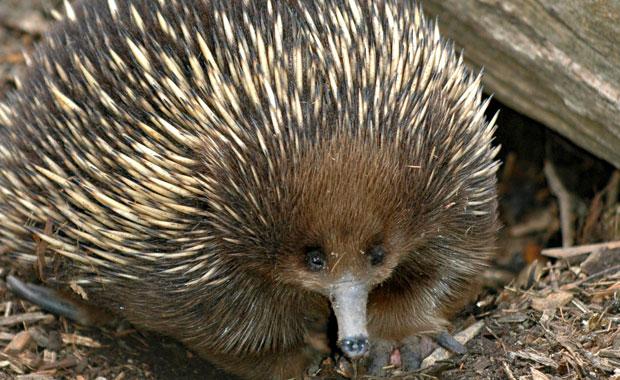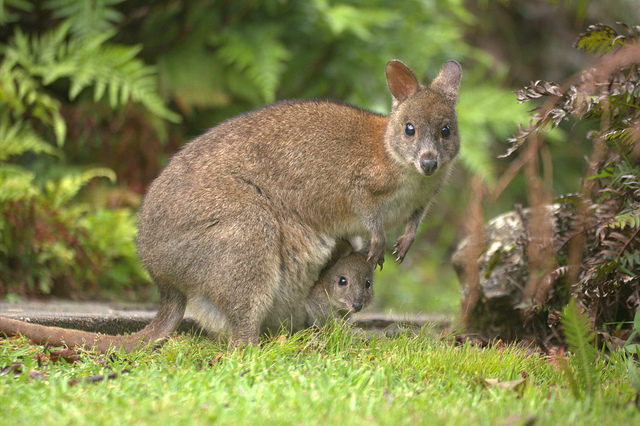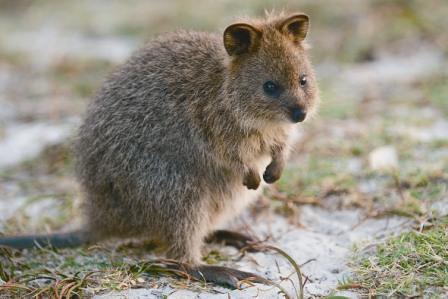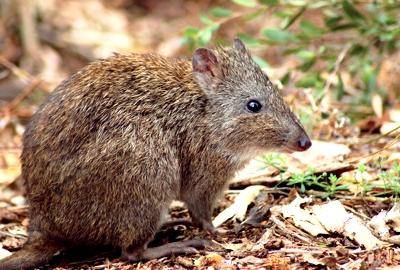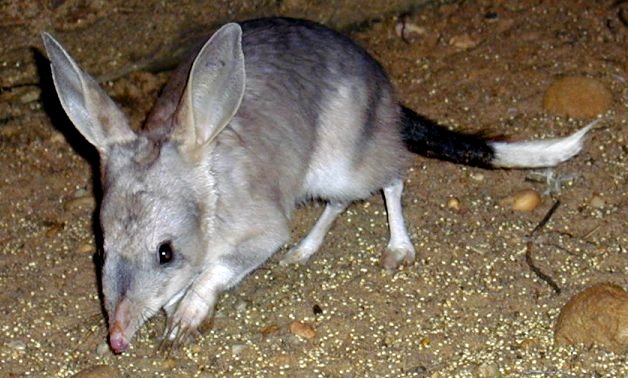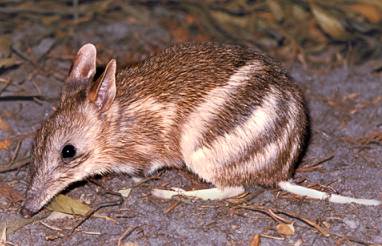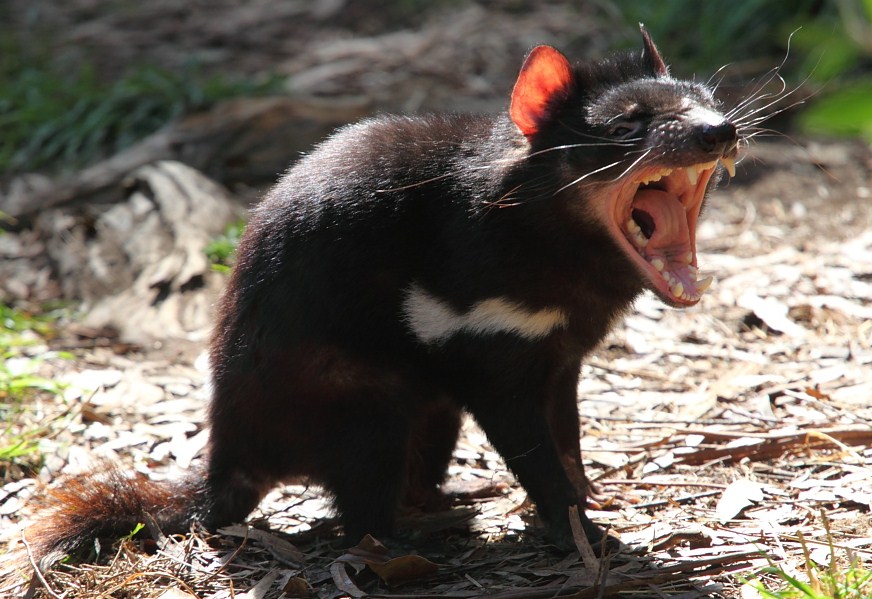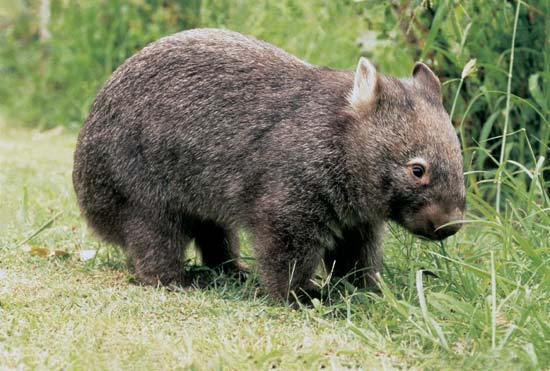Difference between revisions of "Physical World/Mammals - 1"
(Created page with "{| class="wikitable" | |'''Duck-billed platypus''' ''Ornithorhynchus anatinus'' Egg-laying mammal endemic to eastern Australia, including Tasmania The male platypus h...") |
(Added images) |
||
| Line 1: | Line 1: | ||
{| class="wikitable" | {| class="wikitable" | ||
| − | | | + | |[[File:Platypus.jpg|none|thumb]] |
|'''Duck-billed platypus''' | |'''Duck-billed platypus''' | ||
| Line 11: | Line 11: | ||
The male platypus has a spur on the hind foot that delivers venom capable of causing severe pain to humans | The male platypus has a spur on the hind foot that delivers venom capable of causing severe pain to humans | ||
|- | |- | ||
| − | | | + | |[[File:Echidna.jpg|none|thumb]] |
|'''Echidna''' | |'''Echidna''' | ||
| Line 23: | Line 23: | ||
Also known as spiny anteaters. Baby echidna is called a puggle | Also known as spiny anteaters. Baby echidna is called a puggle | ||
|- | |- | ||
| − | | | + | |[[File:Pademelon.jpg|none|thumb]] |
|'''Pademelon''' | |'''Pademelon''' | ||
| Line 34: | Line 34: | ||
Usually found in forests | Usually found in forests | ||
|- | |- | ||
| − | | | + | |[[File:Quokka.jpg|none|thumb]] |
|'''Quokka''' | |'''Quokka''' | ||
| Line 42: | Line 42: | ||
The quokka is herbivorous and mainly nocturnal. Quokkas can be found on some smaller islands off the coast of Western Australia, in particular on Rottnest Island just off Perth. It is about the size of a domestic cat | The quokka is herbivorous and mainly nocturnal. Quokkas can be found on some smaller islands off the coast of Western Australia, in particular on Rottnest Island just off Perth. It is about the size of a domestic cat | ||
|- | |- | ||
| − | | | + | |[[File:Potoroo.jpg|none|thumb]] |
|'''Potoroo''' | |'''Potoroo''' | ||
| Line 54: | Line 54: | ||
Gilbert's potoroo is Australia's most endangered animal | Gilbert's potoroo is Australia's most endangered animal | ||
|- | |- | ||
| − | | | + | |[[File:Opossum.jpg|none|thumb]] |
|'''Virginia opossum''' | |'''Virginia opossum''' | ||
| Line 62: | Line 62: | ||
The only marsupial found in North America north of Mexico. In the United States, it is typically referred to simply as a possum. It is a solitary and nocturnal animal about the size of a domestic cat. | The only marsupial found in North America north of Mexico. In the United States, it is typically referred to simply as a possum. It is a solitary and nocturnal animal about the size of a domestic cat. | ||
|- | |- | ||
| − | | | + | |[[File:Bilby.jpg|none|thumb]] |
|'''Bilby''' | |'''Bilby''' | ||
| Line 74: | Line 74: | ||
An Australian desert-dwelling marsupial omnivore. Bilbies have a long muzzle and very long ears | An Australian desert-dwelling marsupial omnivore. Bilbies have a long muzzle and very long ears | ||
|- | |- | ||
| − | | | + | |[[File:Bandicoot.jpg|none|thumb]] |
|'''Bandicoot''' | |'''Bandicoot''' | ||
| Line 83: | Line 83: | ||
Small to medium-sized, terrestrial marsupial omnivores. They are endemic to the Australia–New Guinea region. Name means "pig rat" | Small to medium-sized, terrestrial marsupial omnivores. They are endemic to the Australia–New Guinea region. Name means "pig rat" | ||
|- | |- | ||
| − | | | + | |[[File:Tasmanian devil.jpg|none|thumb]] |
|'''Tasmanian devil''' | |'''Tasmanian devil''' | ||
| Line 94: | Line 94: | ||
Now found in the wild only on Tasmania | Now found in the wild only on Tasmania | ||
|- | |- | ||
| − | | | + | |[[File:Wombat.jpg|none|thumb]] |
|'''Wombat''' | |'''Wombat''' | ||
| Line 106: | Line 106: | ||
Fatso the Fat-Arsed Wombat was an unofficial mascot of the Sydney 2000 Summer Olympics | Fatso the Fat-Arsed Wombat was an unofficial mascot of the Sydney 2000 Summer Olympics | ||
|- | |- | ||
| − | | | + | |[[File:Koala.jpg|none|thumb]] |
|'''Koala''' | |'''Koala''' | ||
Revision as of 17:40, 3 July 2021
| Duck-billed platypus
Egg-laying mammal endemic to eastern Australia, including Tasmania
| |
| Echidna
| |
| Pademelon
Besides their smaller size, pademelons can be distinguished from wallabies by their shorter, thicker, and sparsely haired tails
| |
| Quokka
The quokka is herbivorous and mainly nocturnal. Quokkas can be found on some smaller islands off the coast of Western Australia, in particular on Rottnest Island just off Perth. It is about the size of a domestic cat | |
| Potoroo
| |
| Virginia opossum
The only marsupial found in North America north of Mexico. In the United States, it is typically referred to simply as a possum. It is a solitary and nocturnal animal about the size of a domestic cat. | |
| Bilby
| |
| Bandicoot
| |
| Tasmanian devil
The size of a small dog, it became the largest carnivorous marsupial in the world following the extinction of the thylacine in 1936
| |
| Wombat
| |
| Koala
An arboreal herbivorous marsupial. Its closest living relatives are the wombats. Because their eucalypt diet has limited nutritional and caloric content, koalas are largely sedentary and sleep for up to 20 hours a day. Koala is one of the few mammals (other than primates) that have fingerprints. Name means “no drink" | |
| Quoll
A carnivorous marsupial native to Australia and New Guinea. It has a brown coat with white spots. It is primarily nocturnal | |
| Elephant shrew
Also known as sengis | |
| Tenrec
Found on Madagascar and in parts of the African mainland | |
| Golden mole
| |
| Aardvark
Feeds almost exclusively on ants and termites. The name comes from earlier Afrikaans and means ‘earth pig’. Aardvark is sometimes colloquially called antbear, anteater, or the Cape anteater | |
| Hyrax
They are often mistaken for rodents, but are more closely related to elephants and manatees. Four species are recognised; the rock hyrax (pictured), the yellow-spotted rock hyrax, the western tree hyrax and the southern tree hyrax | |
| Borneo elephant
| |
| Armadillo
| |
| Giant anteater
Also known as the ant bear
| |
| Pika
| |
| Groundhog
| |
| Prairie dog
They are a type of ground squirrel. Burrowing rodents native to the grasslands of North America
| |
| Gopher
| |
| Kangaroo rat
The common name derives from their bipedal form. They hop in a manner similar to the much larger kangaroo, although they are not related. Native to North America | |
| Baluchistan pygmy jerboa
| |
| Norway lemming
Lemmings do not commit mass suicide when they migrate | |
| Mara
A genus of the cavy family. These large relatives of guinea pigs are common in the Patagonian steppes of Argentina | |
| Capybara
The largest living rodent in the world (ahead of the beaver and porcupine). Found wild in much of South America
| |
| Paca
| |
| Degu
Small rodent endemic to Chile. It is sometimes referred to as the brush-tailed rat
| |
| Common agouti
Native to the Americas. They are related to guinea pigs and look quite similar, but are larger and have longer legs | |
| Colugo
| |
| Slow loris
Only venomous primate. The toxin is produced by licking a gland on their arm, and the secretion mixes with its saliva to activate it
| |
| Galago
| |
| Potto
In the same family as the lorises
| |
| Ring-tailed lemur
The most recognized lemur due to its long, black and white ringed tail. Like all lemurs it is endemic to the island of Madagascar and female dominant | |
| Aye-aye
A lemur native to Madagascar and the world’s largest nocturnal primate Aye-ayes tap on the trunks and branches of the trees, and listen to the echo produced to find hollow chambers inside. Once a chamber is found, they chew a hole into the wood and get grubs out of that hole with their narrow and bony middle finger | |
| Tarsier
|

